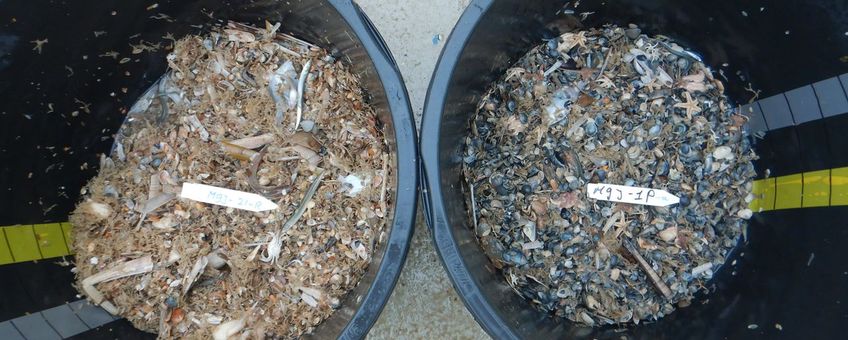
How does benthic life develop in an abandoned sand extraction pit?
NIOZ Royal Netherlands Institute for Sea ResearchHow does benthic life develop in sand extraction sites, in which sand up to 6 meters has been excavated? This was investigated by the Royal Netherlands Institute for Sea Research (NIOZ) and Wageningen Marine Research (WMR) in 2022 for the Sand from the Sea programme (Rijkswaterstaat and the LaMER Foundation).
In The Netherlands, we extract a lot of sand from the North Sea, intended for maintaining The Netherlands' coastline and building infrastructure and buildings. To keep meeting the growing demand for sand, sand extraction wells are getting deeper and deeper. It used to be two meters, but today we regularly dig about six meters deep into the seabed.
"There are major effects visible from this deeper sand extraction on the ecological development of the bottom life in such a sand extraction pit", says Rob Witbaard, ecologist at the Royal Netherlands Institute for Sea Research (NIOZ). "Even 12 years after sand extraction, the biodiversity in an old sand extraction site still clearly differs from its surroundings. Those areas are like scars on the seabed."
Ecological development intermediate-deep sand pits
Previous research showed that soil life in shallow sand extraction pits (up to two meters deep excavation) recovers to the original ecological situation within four to five years. It is also known that the original soil life does not return after very deep extraction in a sand pit of about 20 meters deep. In such a deep well, a muddy soil develops with other species that are suited to it.
Sand from the Sea, the joint research programme of Rijkswaterstaat and the commercial sand extractors of the LaMER Foundation, aims to know how soil life develops in intermediate-deep sand extraction pits, in which sand up to six meters has been excavated. In spring 2023, NIOZ and WMR have delivered the research results. Results from other sub-studies are also expected later this year.
Comparing soil fauna
In the spring of 2022, the researchers sampled four abandoned intermediate-deep sand extraction pits of different ages (ranging from two to 12 years old) as well as surrounding reference areas. This was done using a so-called bottom scraper, which mainly samples the larger benthic animals (larger than 5 millimetres) such as shellfish, starfish, crustaceans, and benthic fish such as sand lance. Besides benthic animals, water depth, grain size and the percentage of organic matter in the seawater were measured.

Pit captures mud
The researchers see clear differences between the sand extraction pits and the reference areas. Fine sediment and organic matter collect in these pits, probably because flow velocities are lower there due to the increased depth. This muddy sediment affects the composition of soil life. Although more animals and more biomass were found in the sand extraction pits, biodiversity has declined. Animal species that like food particles which are settling down, such as the sea urchin (Echinocardium cordatum), are doing well. But species that filter their food from water, such as most shellfish, are instead mostly absent from these old sand pits. It is also notable that some species which are characteristic to our sandy coast are missing in the sand extraction pits, such as the half-naked beach shell (Spisula subtruncata) and the sand lance (Ammodytes sp.). These species are an important food source for predatory fish, birds, and marine mammals.
Some recolonisation, no recovery
The study shows that a vibrant bottom-dwelling animal community can form again within two years in an intermediate-deep sand extraction pit. But the soil composition and the benthic animal community has changed compared to the surrounding seabed. Even though recolonisation has taken place, there has been no recovery to the original situation. Even 12 years after sand extraction, a sand extraction site still clearly differs from its surroundings. For each pit, the degree of silt sedimentation and the development of bottom life varies greatly. Besides the depth of the well, it is still unclear which factors determine the development of a sand extraction pit. Upcoming studies may shed light on this.
Scars on the seabed?
The research results show that the depth of the sand extraction well (two, six or twenty meters deep) greatly influences the development of soil life in the pit. The insights gained into the ecological effects of sand extraction help determine how and where to extract much-needed sand; the sand extraction strategy. The deeper we extract sand, the longer these sand extraction wells remain physically and biologically different from the original situation. When determining the best sand extraction strategy, other considerations besides ecology come into play – including the perspective of spatial planning. Costs and practical feasibility also come play a role. And what does sea level rise mean for the sand extraction strategy in the coming decades? The knowledge from the now-published study provides more guidance for determining this future sand extraction strategy.
More information
- The dossier Deep sea at the NIOZ-website.
Text: NIOZ
Photos: Rob Witbaard (lead photo: difference in catch between outside (left) and inside (right) a sand extraction site)
